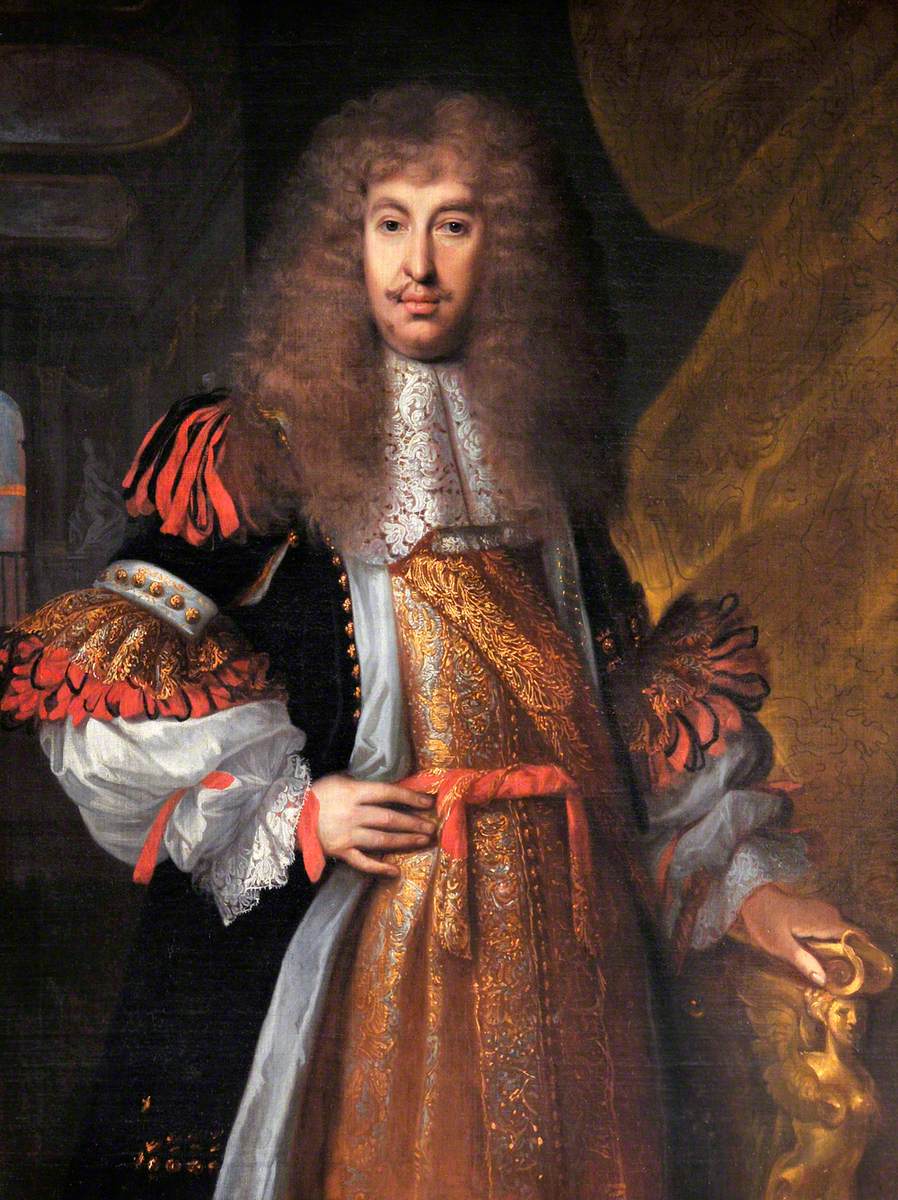The 1660s fashion for vast amounts of ribbons on a man’s suit, probably best exemplified by the survival of Edmund Verney’s 1662 wedding suit [Figure 1] in the Claydon House collection of the National Trust, caused John Evelyn to write:
“It was a fine silken thing which I spied walking th’other day through Westminster Hall that had as much ribbon about him as would have plundered six shops and set up twenty country pedlers. All his body was drest like a May-Pole or Tom o’ Bedlam’s cap. A frigate newly rigged kept not half such a clatter in a storm as this Puppet’s Streamers did when the Wind was in his Shrouds; the Motion was wonderful to behold, and the well-chosen colours were Red, Orange and Blue, of well-gummed Satin which argued a happy fancy.” (1)
Verney’s ribbons were a, possibly more tasteful, pastel blue, pink, yellow and lilac, 216 yards of them. (2 pp. 14-5)
Figure 1: Edmund Verney's wedding suit, 1662. National Trust
These sets of ribbons were sometimes
referred to as fancies, Miles Stapleton paid for “two peeces of taffy ribbin
for fancyes for my suit.” (3) At other times the
sets of ribbons are referred to as garnitures. A 1706 dictionary has “Garniture,
the trimming of a Suit with Ribbons.” (4) A suit for Humphrey
Ferrers in 1667 had “a cherry colour garniture of three peeces of 4d and 3
peeces of figur'd ribon £3 12s 0d.” A “peece” of ribbon is the full length as
it is woven, usually 22 yards, so six pieces for his garniture would be 132
yards of ribbon. (5 p. 126)
Dryden’s makes fun of the fashion in his Secret-love, or, The maiden-queen. Florimel, a female in a man’s habit, says of herself that she can, “set my Hat, shake my Garniture, … if I should be mistaken for some Courtier now, pray where's the difference?” When Celadon says he will fight her, she replies, “Out upon fighting; 'tis grown so common a fashion, that a Modish man contemns it; A man of Garniture and Feather is above the dispensation of the Sword.” (6)
The garnitures could be placed at the shoulder, cuffs, front and sides of the tops of the breeches, and `at the bottom of the breeches. In 1670 John Ferrers’ tailor charges for “a crape shoulder knott coate knotts, garters & knotts to the breeches £1 10s “ The exaggerated extent this could go to can be seen in the 1666 portrait of Herzog Maximilian Philipp von Bayern (1638-1705). The portrait of Henry Howard by John Michael Wright [Figure 2] shows shoulder and sleeve knots, as the long waistcoat came into fashion the tops of the breeches were hidden, so the ribbons of them disappeared.
 |
| Figure 2: Henry Howard by John Michael Wright, c.1669. National Trust |
Shoulder knots however continued to be in fashion throughout the 1670s. Tankard’s examination of the tailors’ bills of Edward May and Samuel Jeakes show that in 1681 and 1682 both had suits made with shoulder knots. May’s coat had a shoulder knot of scarlet and silver ribbon, with his tailor also providing a scarlet hat band. Jeakes’s tailor advised him that “I am told a ribbon [for the hat] the same as the shoulder knot is quite out of wear.” (7 p. 114 & 120) The shoulder knot alone contained a considerable amount of ribbon with William Watts, the Ferrers family tailor, charging nine shillings for “9 yds of figur'd & 18 yds of 4d ribon for a shoulder knot.” (5 p. 135)
While the Ferrers family bills in the 1660s and early 1670s have livery for the footmen and the coachmen, they do not have shoulder knots. By the mid eighteenth-century shoulder knots, always on the right shoulder, had become part of a servant’s livery, especially the sign of a footman. A runaway servant in 1731 is described in an advertisement as wearing “a dark brown cloth coat [with] a scarlet shoulder knot.” (8 p. 34)
References
1. Evelyn, John. Tyrannus, Or, The Mode: In a Discourse of Sumptuary Lawes. London : G. Bedel and T. Collins at the Middle Temple Gate, and J. Crook at the Ship in St Paul's Churchyard, 1661.
2. National Trust. Arts, Buildings & Collections Bulletin. Autumn 2014.
3. Cox, J. Charles. The Household Books Of Sir Miles Stapleton, 1656-1705. The Ancestor. 1902.
4. Phillips, Edward. The New World of English Words, or, a General Dictionary. London : J. Phillips, 1706.
5. Ferrers Family of Tamworth Castle. Transcripts from the archives.
6. Dryden, John. Secret-love, or, The maiden-queen. London : Printed for Henry Herringman, 1668.
7. Tankard, Danae. Clothing in 17th century provincial England. London : Bloomsbury, 2020.
8. Cunnington, Phillis. Costume of Household Servants. London : Black, 1974.

No comments:
Post a Comment
Note: only a member of this blog may post a comment.